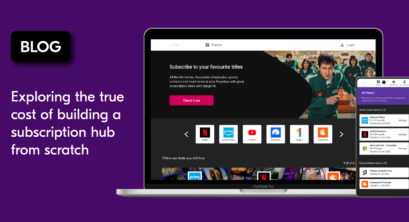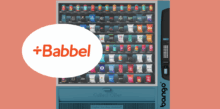Bango DVM CX: exploring the true cost of building a subscription hub from scratch
by Cei Sanderson | 11 Apr 2025

The world runs on subscriptions. From games to software to movies and music, people don’t buy, they subscribe. And it works. No more shelves full of dusty DVDs. Now, everything is streamed digitally across all your devices – TVs, tablets, laptops, you name it. Thousands of titles, always up to date, just a click away. According to Deloitte, Gen Z and millennials are more likely to favor car subscription service over ownership model.
Easier? More flexible? More choice? Yes to all three.
It’s why the subscription media sector will rocket from US$100B in 2018 to over US$1T by 2028. The World Economic Forum even floated the idea that “You’ll own nothing, and be happy.”
I wouldn’t go as far as the WEF. (It’s nice to own a toothbrush and some clothes, for example.) But there’s no doubt consumers find subscription content attractive, especially when it’s available in nice, neat bundles from their telco, broadband provider, bank or retailer. So, if you provide any of these services – fixed line, mobile, internet or a financial service – there’s an obvious opportunity to sweeten the deal. (Free month of Netflix? Discount on Disney+? Take my money, say consumers.)
But there’s a catch. Presenting that array of offers and choices as a simple and smooth customer experience is a huge point of failure for many resellers. Different content providers, diverse contracts in play, new relationships to be nurtured. And that’s before you build out the backend infrastructure of APIs, apps, accounts, and a dozen other capabilities. Making a proposition for a flexible, cost-effective solution to manage all subscriptions in one place becomes not only a significant cost base that would outrun the returns but could negatively cause indecision and abandonment when acquiring new customers.
As you’d guess, there’s a solution. But to put it in perspective, let’s look first at what you’d have to deal with if you did try to develop a subscription bundling solution on your own – with the true costs of building a subscription hub from scratch.
Trouble at the hub: building your own from scratch
Let’s divide the challenge into three stages. First comes building a subscription hub itself: a new venture, needing an inhouse team and dedicated infrastructure. Second, meeting consumer expectations with a sleek user experience. Third, the ongoing costs of maintaining, evolving, and staying current with the market. Let’s look at each.
- Implementing your Minimum Viable Product: it’s no small thing
You’ve got board sign-off and the green light to build your subscription hub – now comes the real work. Your internal teams are experts at running high-performance networks and delivering core services. But diverting their time to design and build a subscription platform from scratch means pulling them away from their core strengths.
The pace of change in the subscription world is relentless. Content providers tend to move faster – testing, iterating, and adapting to user expectations in near real-time. Operators, by contrast, often need to plan around asynchronous systems and regulatory structures. These fundamental differences in rhythm make it all the more important to bring in specialist partners who live and breathe this space – not because your team can’t, but because they shouldn’t have to.
Initial development: getting decisions right from Day One
The early decisions shape everything. This isn’t just about picking cloud platforms or API frameworks, it’s about choosing the right foundation. You don’t need to build a subscription hub from scratch when proven solutions already exist. The smart move is to work with a partner that’s built specifically for subscription bundling and knows how to get you to market quickly.
That kind of expertise saves time, avoids complexity, and means you’re not learning the hard way. But even with the right partner, internal leadership matters. This isn’t a side project. It needs focus, coordination, and often a dedicated team to get it right.
Yes, there’s upfront effort. But the payoff is speed, stability, and a platform you can actually scale. Get it right from Day One, and everything else gets easier.
Time for testing: where most development actually happens
Next comes the test phase for your new sub-hub. It’s where most of the real development happens. Ironing out the details, fixing what doesn’t work, and finding the gaps you didn’t know were there. No matter how sharp your Gantt charts look, testing always takes longer than anticipated.
The real test, though, happens in the hands of customers. And that’s where it matters most. Imagine a customer who’s excited to claim their three-months Netflix offer – only to find the link doesn’t work, or the code won’t arrive for weeks. That doesn’t just frustrate them. It undermines trust, not just in the offer, but in your brand overall.
Handled well, this is a value-add that strengthens loyalty. Handled badly, it drives churn. The smallest technical slip can have a much bigger business impact – so it pays to get it right before launch.
- Ongoing maintenance and development: a continual cost sink
When you bring content services together on a hub, there are a thousand things going on behind the scenes. One content provider may change its API; a new service integration may affect the CX in an odd way; data sources and protocols need updating regularly as the subscription management website feeding your hub evolves. And that’s for a single offer from a content provider. It’s likely you’ll be offering more than one.
Maximizing the opportunity: changing to keep customers happy
You’ll also want to onboard new content providers to attract and retain customers – each of which is a new project that spans multiple departments like strategy and marketing as well as IT.
The prize is to be the consumer’s first choice for all their content, so they stay with you for years, decades, even their whole lives. This means development never really ends. With new technologies and processes to deal with, it’ll feel like you’re building a new digital subscription hub continuously. So don’t think you can part with your developers just yet.
- Creating an outstanding customer experience: the critical consumer
Yes. There’s even more! Let’s assume you’ve done all the above and get it right first time. Now you’ve got to choose the right subscriptions and offers for your target audience. And that’s what your youngest would call “a bit delulu”. Let’s see why.
Tastes and trends: what subscriptions do they want?
Your business case for a subscription hub rests on reading consumer preferences right. Will they like the subscriptions you plan to offer? Have you got the right mix? Are you offering bundles that make thematic sense, like “Sports” or “Kids”?
It’s not as easy as it sounds. Content preferences depend on geographic, demographic, behavioral and psychographic insights. And the data you have about your customers may not tell you that. So, there’s research to be done… adding to those costs again.
Unified billing: where one size must fit all
Of course, paying for the subscriptions consumers love on their broadband bill is THE big benefit you’re offering. 63% of US consumers want to manage all subscriptions in one place (Bango Survey, Subscriptions Assemble 2025), with around 50% stating that they would leave their current telco if someone else was offering this solution.
Unfortunately, it’s also the most complex part of creating great customer experience for your digital subscription hub.
When do you communicate that a free trial is about to end? What are your retention strategies when they leave? How do you deal with reporting back to the content provider, so you get credited for a new signup? What if a customer takes up a bundle but already subscribes to one of its streaming services separately?
Working through these puzzles is all part of building a digital services hub – and it’s both a customer service AND technical maintenance issue.
Even if things go to plan – which they never do – you’re looking at rising costs, delays, and teams stretched thin. Yes, control sounds great. But most resellers don’t want to own the complexity. They just want results.
That’s why the smart move is to work with experts who’ve already built the infrastructure, solved the problems and know how to scale. You get control where it counts most with getting buried in the build.
No arguments from Bango – that’s a great value-add. But what if you could get it all without the hassle?
Bango DVM CX – Prebuilt white label subscription hub that is standardized and configurable enabling speed to market
Before you dive into self-build, here’s a quick tip: all the issues above have already been solved – with a third-party product that does everything you want that fits into existing systems you already have.
Instead of navigating the complexities of building a hub from zero, take a look at the Digital Vending Machine from Bango, or DVM for short. Here’s what it offers:
- Faster rollout means a shorter time-to-market. Bango DVM CX (a white-label subscription hub) can be part of your processes in just weeks – in your own branding, your own configuration and all the content provider connections already there.
- All the tools to engage consumers, ready-to-go. Contains pre-built user journeys with precise localization, seamless integration, and easy payment features that keep your audience up close and personal.
- Opportunities for content providers, too. If third party channels (indirect) sell your subscriptions, there are value-adds for them all, thanks to time-saving services for checking a customer is eligible, enabling smooth transactions, and offering the content they want.
- Expedited entry to new markets. With over 100 content providers live connections already part of DVM ecosystem, you can start offering incentives the moment you start marketing in a new region – even if you had no relationships there before.
- Unique and personalized bundles. With the DVM, telcos aren’t limited to a preset selection of content providers. Mix and match your own bundles to appeal to your audience, in whatever depth of detail you want.
- Back-end administration. Between telco, consumer and content provider, the DVM dots every ‘i’ and crosses every ‘t’, with APIs and cloud services connecting it all.
That’s Bango DVM CX. A pre-built, white-label digital subscription hub that lets you offer bundled subscriptions from third-party providers to your consumers… without the costs and hassles of doing it yourself. Improving time-to-market, reducing risk, cutting costs, and outsourcing ongoing issues to the experts in subscription bundling.
CONCLUSION: Where costs can climb, scale with Bango DVM instead
Need more proof? The Digital Vending Machine (DVM) is already in play at major global telcos, helping acquire and retain consumers while offering flexibility of choice and a great customer experience in a complex world of subscriptions.
You can do the same. All for your own customers… under your own branding… and your own control. Just as if you’d built it all yourself.
So stop wondering about true cost – and start thinking about true value.
Subscribe to our newsletter
Get the latest subscription bundling news and insights delivered straight to your inbox.



